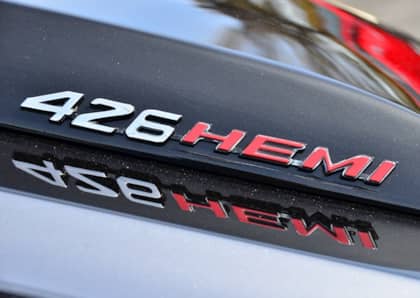A History Of The Max Wedge: 426 Cubic Inches of Race-Winning Muscle Car Madness For Less Than A Hemi
The numbers '426' have long been associated with the famous Chrysler Hemi, that legendarily unbeatable engine that conquered both Detroit's Woodward Ave and the high banks of Daytona in the heat of NASCAR competition. Well before the big block version of the Hemi ever made it to market, however, there was another engine family that also punched out those same cubic inches on both the street and the track: the Max Wedge.

Although it's been pushed out of the collector car pop consciousness by its more famous cousin, Mopar's race-bred Max Wedge enjoyed an equally dominant reign over both the stoplight grand prix and the professional drag racing circuit. For four years at the beginning of the 1960s, Dodge and Plymouth were able to make a legitimate claim as being among the first muscle cars ever built thanks to their thundering, and now largely forgotten, Max Wedge engines.
Simplify, But Add Cubic Inches
The Hemi made its original appearance in the early 1950s as part of Chrysler's first V8 program. While successful, these small block motors were heavy and expensive to build, and by the end of the decade a new design was finding favor across the company's brands.

Dubbed the 'RB' or 'Raised Block' V8s, these engines swapped complicated head designs for cubic inches. Still, the heads made a difference: the new 'wedge' shaped combustion chambers would give the Max Wedge package the name under which it was marketed. Originally debuting on 413 cubic inch motors, the Max Wedge featured significantly larger ports and valves, forged rods and pistons, an aggressive camshaft, twin carburetors, and a compression ratio of up to 13.5:1. Power was rated at a maximum of 420 ponies with torque checking in at an incredible 500 lb-ft.

The Max Wedge was introduced in 1962 in a number of mid-size models offered by Plymouth (the Super Stock 413) and Dodge (the Ramcharger 413). Unlike past performance efforts from Chrysler, these vehicles were aimed specifically at buyers who wanted to put the competition to shame on the drag strip. It wasn't long before Max Wedge cars were breaking into the 11's in NHRA competition, led by the 'Dodge Ramchargers' team of engineers that took on all comers on their way to a U.S. National class win.
This forced General Motors and Ford to develop their own drag-oriented packages like the Fairlane Thunderbolt, the Chevelle 396, and of course the fabled Pontiac GTO and its SD cousins.
Who Needs A Hemi?
Chrysler had scooped its rivals in building a drag pack for the street, so it was no surprise that by the time the Blue Oval and the Bowtie had caught up to the Max Wedge there was a new iteration waiting in the wings. In 1963 Chrysler introduced a 426 cubic inch version of the motor that was good for as much as 425 horsepower (or 415 if found in 11.0:1 compression form). The motor was again available across almost all mid-size Dodges and Plymouths by way of a simple two-digit order code and a modest $445 surcharge over the base slant six engine, but you had to be in the know to fill out the build sheet properly, as Mopar didn't advertise the Max Wedge in its brochure.

What were they like to drive on the street? Truth be told, with their aggressive cam specs the high compression Max Wedge cars were a bit of a handful, and they were also much more maintenance-intensive than one would expect from a daily driver. It was partly for this reason that, even after dropping to a 12.5:1 ratio for 1964, Chrysler decided to go back to its Hemi heritage.

The big block stayed, but by the following year the Wedge was out and the Hemi was in as the brand's new muscle car champion.
An Affordable Legend
The bright side to the Max Wedge's lower profile among collectors is that it's not nearly as expensive to own a Ramcharger or Super Stock today. Building a Wedge so that you can stuff its glorious cross-ram intake under the hood of your own hot rod is also much more affordable than paying the Hemi tax on the other famous 426.

Original Max Wedge heads can be expensive to source, but there are a number of modern head designs with similarly-sized intake ports that can be used in conjunction with the cross-ram (which doesn't tend to play nice with non-Wedge heads of the era). Mopar also now offers a reproduction intake for those who are looking for power rather than all-original authenticity. Match that with any of the high-CFM carbs currently available from vendors like Edelbrock in place of the original Carter units, and you can put together a unique drivetrain that is just as mighty as the Hemi, but far less commonly cloned.

The Max Wedge might have had too short a season back in its heyday, but it deserves to be remembered alongside the 396, the Thunderbolt, and the GTO as one of the originators not just of barely street legal drag cars, but also the entire muscle car movement.
More From Driving Line
- What other engines from the 1960s have been ignored by modern collectors? Check out these Big Sixes that took on their V8 rivals head-to-head.











